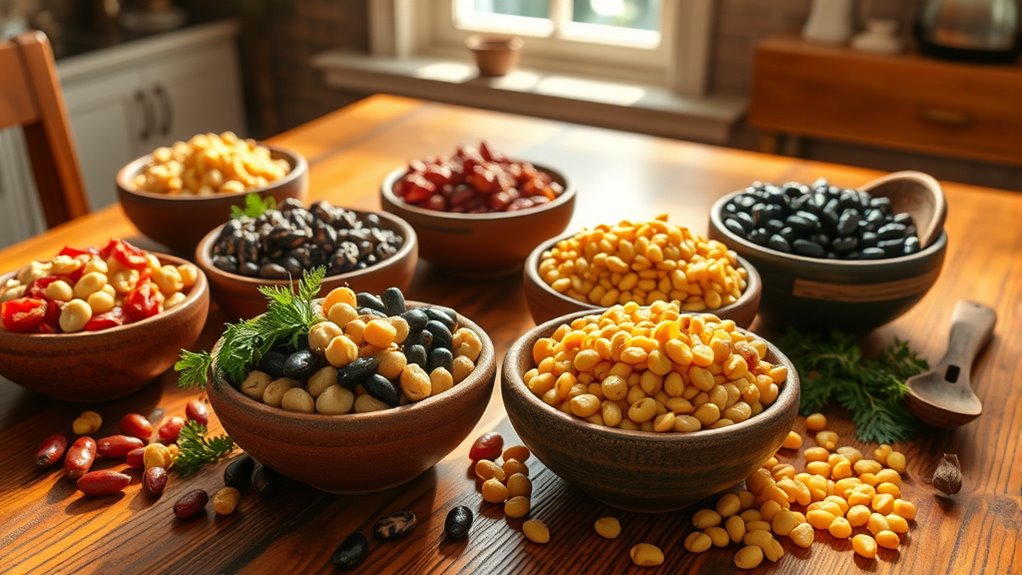Embracing beans and legumes in your diet is an easy way to boost fiber, protein, and essential nutrients that support digestion, heart health, and weight management. You can incorporate them into salads, soups, or spreads, using canned options for quick meals or dried beans for richer flavor. Just rinse canned beans well and cook dried ones thoroughly. Staying consistent with these foods helps meet your daily nutritional goals—keep exploring to learn more simple ways to enjoy them.
Key Takeaways
- Incorporate a variety of beans and legumes regularly to boost fiber, protein, and essential nutrients in your diet.
- Use simple cooking methods like soaking dried beans or rinsing canned ones for quick, nutritious meals.
- Enhance dishes with herbs, spices, and vegetables to make bean-based meals flavorful and satisfying.
- Include beans in salads, stews, or spreads to diversify your diet and improve digestion and heart health.
- Opt for nutrient-rich options like lentils, kidney beans, and navy beans to maximize health benefits.

Incorporating beans and legumes into your diet offers a simple way to boost your nutrition and improve overall health. These versatile foods are packed with essential nutrients, making them a smart addition to any meal plan. From fiber and protein to vitamins and minerals, beans and legumes provide a wide range of nutritional benefits that support digestion, heart health, and sustained energy levels. Whether you’re looking to manage weight, lower cholesterol, or simply eat more plant-based foods, adding beans to your meals can have a positive impact.
Adding beans and legumes boosts nutrition, supports digestion, and promotes heart health in simple, delicious ways.
To make the most of these ingredients, it’s helpful to understand some effective cooking tips. First, soak dried beans before cooking—they reduce cooking time, improve digestibility, and help remove substances that can cause bloating. You can soak them overnight or use a quick-soak method by boiling them briefly, then letting them sit for an hour. When cooking, use fresh water and avoid adding salt or acidic ingredients until beans are tender; salt can toughen their skins, prolonging cooking time. For added flavor, toss in herbs, garlic, or spices during cooking, and consider using vegetable broth instead of water for a richer taste.
Canned beans are a convenient alternative, but be sure to rinse them thoroughly to remove excess sodium and any canning residues. Incorporate beans into salads, soups, stews, or even mash them into spreads. Their mild flavor pairs well with a variety of ingredients, so don’t hesitate to experiment with different cuisines—think spicy chili, Mediterranean hummus, or Mexican refried beans. When adding beans to your dishes, balance them with fresh vegetables, lean proteins, and whole grains to maximize nutritional benefits and create satisfying, balanced meals.
Additionally, integrating beans and legumes into your diet doesn’t require complex recipes or special skills. Simple preparations like adding black beans to your morning breakfast bowl or tossing chickpeas into a salad can make a significant difference. Keep dried and canned options on hand for quick meal assembly, and try incorporating a variety of types—such as lentils, kidney beans, or navy beans—to enjoy their unique flavors and textures. Remember, consistent inclusion of beans can help you meet your daily fiber and protein goals while supporting overall health. Dietary fiber from beans and legumes plays a crucial role in maintaining optimal digestive function and preventing issues like constipation.
Frequently Asked Questions
Are Beans Suitable for People With Allergies?
Beans may not be suitable if you have a bean allergy, as allergy cross reactivity can occur with other legumes. If you’re managing a bean allergy, it’s vital to avoid all related products and consult an allergist for proper bean allergy management. Always check labels carefully and consider testing for cross-reactivity to make sure you’re safe. If you’re uncertain, seek personalized advice from a healthcare professional before including beans in your diet.
How Do I Store Cooked Beans for Later Use?
You should store cooked beans in an airtight container and refrigerate them within two hours of cooking. Follow refrigeration guidelines by keeping them at 40°F (4°C) or lower, which helps prevent bacterial growth. Label the container with the date to keep track of freshness. For longer storage, consider freezing them in portions; just make sure they’re cooled properly before sealing to avoid freezer burn.
Can Beans Replace Meat in All Recipes?
Yes, beans can replace meat in many recipes, serving as effective meat substitutions. They add protein and fiber, making them a hearty alternative. However, consider flavor profiles; beans have a different taste and texture than meat, so you might need spices, herbs, or sauces to enhance the dish. While they work well in many cases, some recipes may still require a small amount of meat or other ingredients for the best flavor and texture.
Are Canned Beans as Nutritious as Dried Beans?
Are canned beans as nutritious as dried beans? The answer might surprise you. While canned beans are convenient and retain much of their nutritional value, their preparation methods—like added salt or preservatives—can affect health benefits. Dried beans, on the other hand, give you control over ingredients and often retain more nutrients. So, choose wisely based on your priorities—ease or maximum nutrition—and enjoy these versatile, protein-rich foods.
What Are the Best Ways to Reduce Gas From Beans?
To reduce gas from beans, try these cooking tips: soak beans overnight to break down indigestible sugars, rinse thoroughly before cooking, and cook them slowly to improve digestibility. You can also add herbs like epazote or ginger to your recipes, which help with gas reduction. Eating smaller portions and gradually increasing intake allows your digestive system to adapt, minimizing discomfort over time.
Conclusion
Incorporating beans and legumes into your meals can boost your health and add delicious variety. Remember, “You are what you eat,” so choosing nutrient-rich options like these can make a real difference. Start small, experiment with different recipes, and enjoy the numerous benefits they bring. Embracing beans and legumes is a simple step toward a healthier, more balanced lifestyle. So, why not give it a try today? Your body will thank you.









